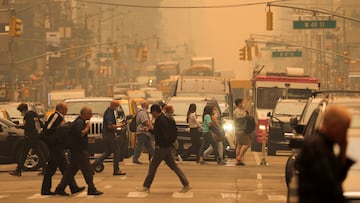Air quality index: What to do when air quality is bad
There are a number of preventative steps you can take to keep safe when air quality is very poor. Here are some of them.


The Blade Runner-esque view for some 100 million people in North America should have people worried about the state of the environment. Canadian wildfires are to blame but only at face value as rising global temperatures look set to make these occurrences more regular.
The Canadian government announced that they are expecting the worst wildfire season on record but this record will be broken over the next two decades. You can track the smoke from the wildfires in real time.
Dangerous smoke from Canadian wildfires has led to a massive dip in air quality in Chicago pic.twitter.com/wg7u1VjnNP
— Reuters (@Reuters) June 28, 2023
US President Joe Biden described the fires as a “stark reminder of the impacts of climate change”.
The Air Quality Index categories has a range from 0 to 500. The two lowest levels go from 0-50, “Good”, represented by green and 51-100, “Moderate”, represented by yellow. Below 100 the air quality is considered to be satisfactory for all groups.
Above that level, from 101-150, “Unhealthy for Sensitive Groups”, represented by orange, the air quality is not likely to affect the general public but those in sensitive groups may experience health effects. The following three levels, “Unhealthy” (151-200 color red), “Very Unhealthy” (201-300 color purple) and “Hazardous” (301-500 color Maroon), the air quality is unhealthy for all groups.
What to do when air quality is poor
With parts of the US swamped in hazy orange cloud, there is plenty you can do to ensure you keep safe now and for future events which destroy the air quality in your area.
Stay indoors as much as possible.
Close all windows and doors to minimize outdoor air infiltration.
Use air purifiers with HEPA filters to clean indoor air.
Wear a mask when you need to go outside. This will need to be the N95 mask for the best protection.
Limit outdoor activities, especially during peak pollution hours.
Related stories
Create a clean indoor environment by avoiding smoking and using strong chemicals.
Stay informed about air quality updates through reliable sources such as the Environmental Protection Agency’s AQI.
All of central Indiana is now in the "very unhealthy category" of the Air Quality Index as the smoke layer from Canadian wildfires becomes more dense.
— WTHR.com (@WTHRcom) June 28, 2023
MORE: https://t.co/MiWIZMp3xI pic.twitter.com/ugIUsmubgs

